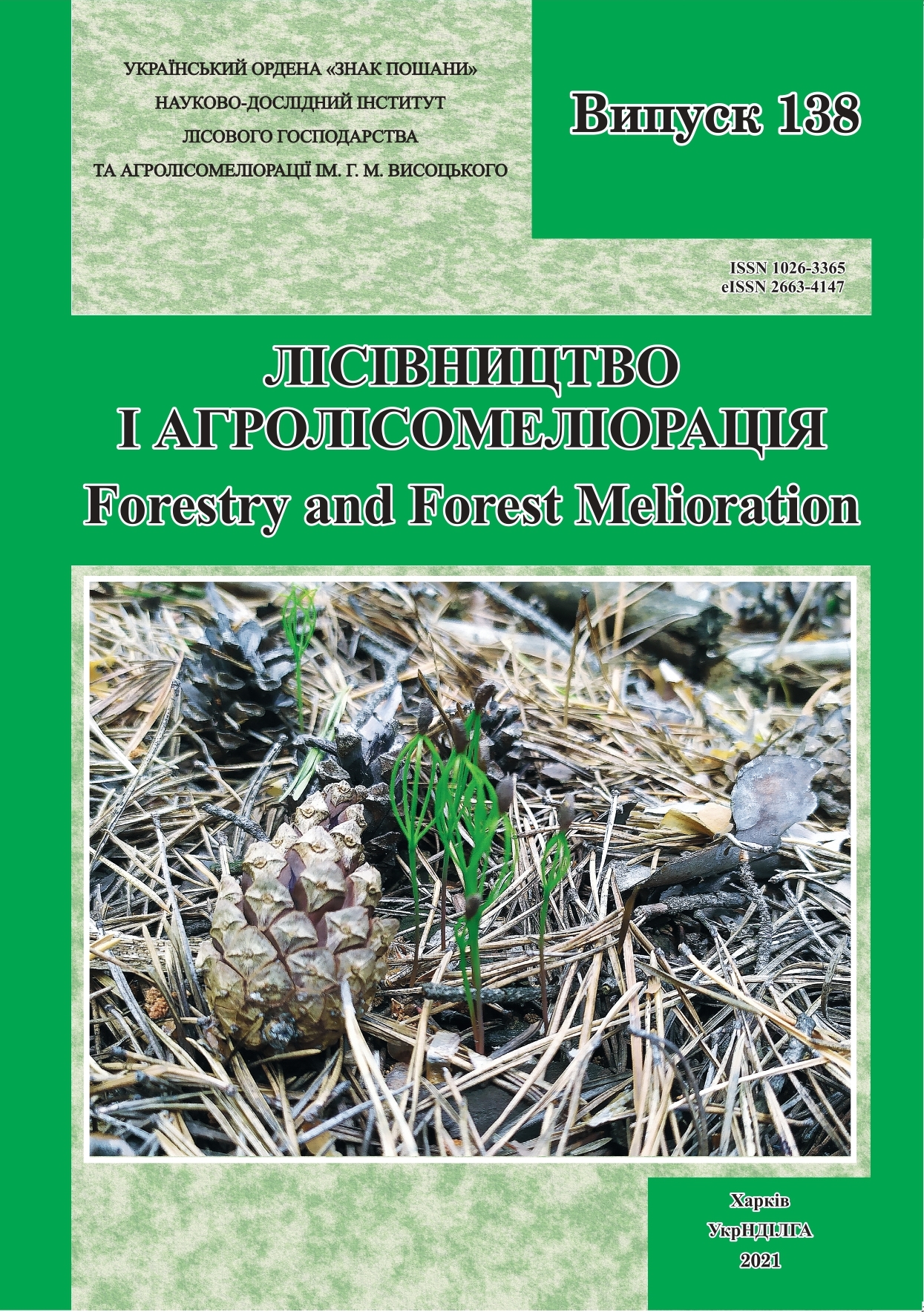Abstract
Introduction
Ukrainian forests perform mainly ecological functions, such as water conservation, soil protection, sanitation, health improvement, and have a limited operational value. Recreational and health-improving forests are an essential component of Ukrainian forests. They cover over 1.6 million hectares, which is almost 15% of the state forest fund. Enhancing biological sustainability, improving forest health and determining functional efficiency of these forests continue to be urgent issues nowadays. To effecctively manage natural resources in recreational and health-improving forests, it is necessary to make scientific forecasts on possible consequences of economic activity as well as to develop proper measures to prevent and eliminate a negative anthropogenic impact upon forest ecosystems and to improve methods of their protection and rational use.
The aim of the study was to describe the condition of recreational and health-improving forests within Left-Bank Ukraine based on the analysis of the forest inventory materials and determine their area and stock distribution by location, types of forest site conditions, species composition, age, relative density of stocking and growth classes.
Materials and Methods
The analysis of the forest fund of Ukrainian recreational and health-improving forests was carried out based on Forest Fund subcompartment database of Ukrderzhlisproekt Production Association including species composition, types of forest site conditions, relative density of stocking, growth classes, stocks as of 01.01.2011. In total, we analysed more than 143 thousand subcompartments in the stands classified as recreational and health-improving forests within Left-Bank Ukraine. Forest management database was transferred from .vff into .mdb MS Access format by means of the programme developed in the Laboratory of Advanced Information Technologies, URIFFM.
Results
The results of the research show that in Left-Bank Ukraine, the area of recreational and health-improving forests is 483,208 ha, or 30.8 % of the total forest area in the study region. The largest part of recreational and health-improving forests of the total area in Left-Bank Ukraine is concentrated within the steppe zone – 38.1%, slightly smaller (34.2 %) is their proportion in the forest-steppe zone, and it is the smallest (15.5 %) in the Polissya zone. Among the recreational and health-improving forests within Left-Bank Ukraine, the largest areas are occupied by woodland areas outside the forests of green zones and forest areas of green zones around settlements, the proportions of which are 99.8, 96.5 and 64.6% of the total area in Polissya, Forest-Steppe and Steppe zones, respectively. Forests in settlements, which take a special place in the system of green plantations of urban areas, occupy only 0.2, 2.5 and 17.7 %, respectively. The species composition of the recreational and health-improving forests in Left-Bank Ukraine is quite diverse and includes 35 tree species in Polissya, 59 in Forest-Steppe and 85 in Steppe. In total, Ukrainian forests, according to the forest management materials, are represented by more than 300 tree species. Within Left-Bank Ukraine, the largest area of recreational and health-improving forests is associated to fertile sites where their proportion is almost 41.0 % (198,000 hectares). The smallest area of the forests is in infertile site conditions – 13.4 % (64,767 ha). Forests in fairly infertile and fairly fertile sites occupy 26.1 and 19.5 % (125,987 and 94,454 ha), respectively. Among all trophotopes, in terms of moisture, fresh hygrotopes occupy the largest area while very dry and dry ones cover the smallest area. . Our study revealed that the age structure of recreational and health-improving forests is unbalanced with a significant predominance of middle-aged stands (ca. 60%). Plantings of other age groups occupy much smaller areas. Within Left-Bank Ukraine, most of the recreational and health-improving forests are characterized by a relatively high productivity. The analysis of the studied forests in terms of their relative density of stocking shows that the largest area is occupied by medium-stocked stands; their proportion in the total area is 57.8%. Less represented are fully stocked stands (40.5%).
Conclusions
In Left-Bank Ukraine, the area of recreational and health-improving forests is 483.21 thousand hectares, or 30.8 % of the total forest area. The area percentage of these forests in the region is increasing from north to south – from Polissia to Steppe. Among the recreational and health-improving forests within Left-Bank Ukraine, the largest areas are occupied by woodland areas outside the forests of green zones and forest areas of green zones around settlements. The species composition of the forests is highly diverse. Within the Left-Bank Polissya, the most common are pine stands; in the conditions of Left-Bank Forest-Steppe these are oak stands, and in the conditions of Left-Bank Steppe the proportiona of the area of pine and oak forests are almost the same. Conditions of Left-Bank Ukraine are generally favourable for the growth and development of the main forest-forming species. The vast majority of the forests have a medium and high relative density of stocking and belong to I–II growth classes, except for the Steppe zone, where forests of II–III growth classes predominate. The age structure of the stands in the studied category of forests is unbalanced with a significant predominance of middle-aged stands. The percentage of mature and overmature stands within the Left-Bank Steppe is quite significant. The proportion of young stands is insufficient in all natural zones.

This work is licensed under a Creative Commons Attribution 4.0 International License.
